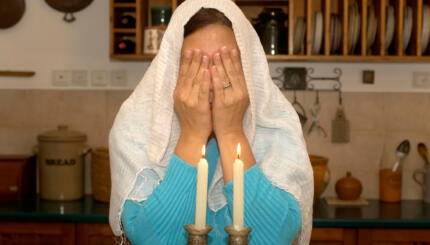The author, when writing about the familiar Jewish ambience of her own childhood and adulthood, uses the traditional terms for (“Shabbos”) and for synagogue (“ ”). Reprinted with permission from How to Run a Traditional Jewish Household, published by Simon & Schuster.
Jewish law forbids the carrying of objects into the public domain on Shabbat; it doesn’t matter if the object is as light as a handkerchief or a house key or as heavy as a book of Talmud. Nor can one push a baby carriage or stroller, or even carry a baby who cannot walk by himself or herself.
This law can definitely clip one’s wings! Particularly with babies, one can feel “locked in” on a Shabbat. But Jews have found a way to resolve it; or, rather, several ways. One way is by having objects that one needs outside of the home available at the other end of the line. For example: having prayer books and Bibles at a synagogue for everyone who comes is a solution to a Jew’s not being permitted to carry his/her own siddur (prayer book) through the streets.
 When I was a teenager, I would periodically apply my talents toward finding a good safe hiding spot for my comb and lipstick in the small ladies’ room of my shul. I couldn’t carry these items, and yet there was no way on earth I would walk into shul without recombing after the ten-minute walk there. So I had to provide for these things properly. Best friends were those girls to whom you would tell where your “Shabbos comb and lipstick” were hidden. When I married, and moved away, I left my comb and lipstick in place. It was like leaving a small part of me behind in the shul of my youth. I wonder if it’s still in place. I know no one is looking anymore, because an eruv has since been put up in that neighborhood.
When I was a teenager, I would periodically apply my talents toward finding a good safe hiding spot for my comb and lipstick in the small ladies’ room of my shul. I couldn’t carry these items, and yet there was no way on earth I would walk into shul without recombing after the ten-minute walk there. So I had to provide for these things properly. Best friends were those girls to whom you would tell where your “Shabbos comb and lipstick” were hidden. When I married, and moved away, I left my comb and lipstick in place. It was like leaving a small part of me behind in the shul of my youth. I wonder if it’s still in place. I know no one is looking anymore, because an eruv has since been put up in that neighborhood.

Help us keep Jewish knowledge accessible to millions of people around the world.
Your donation to My Jewish Learning fuels endless journeys of Jewish discovery. With your help, My Jewish Learning can continue to provide nonstop opportunities for learning, connection and growth.
A second solution is to have craftsmen create things like Shabbos keys. A key, nicely gilded, is affixed to a belt buckle or tie clip or pin back; thus, it becomes part of a person’s clothing or jewelry on which there is no restriction of carrying. One would also tie a handkerchief around the wrist rather than carry it in a pocket. Some of this seems ludicrous to an outsider, but it is all part of the total commitment of an Orthodox Jew.
Privatizing the Public Domain
Still, neither of those solutions addresses the larger problem of taking babies out of doors on Shabbat. But an eruv does. An eruv is a symbolic act by means of which the legal fiction of community or continuity is established. An eruv symbolically transforms a public domain into a large private one; this allows a Jew to carry outside the house items that would normally be permissible to carry from place to place inside the house. In other words, when there’s an eruv enclosure, one may carry on Shabbat, within reason, any item which is not muktzeh [at item without potential use on Shabbat, which, according to rabbinic law, it forbidden to touch].
An eruv encircles a town, and makes it all private property, even though we all know it isn’t private property. An eruv is sometimes nothing more than a wire connected at appropriate points to existing telephone wires, in order to completely close the perimeter. There are eruv checkers and eruv hot lines—to see if the eruv is in order.
In recent years, many communities have constructed eruvin (plural), putting Shabbos keymakers and Shabbos babysitters out of business, but, in general, making life much less complicated and more pleasant for traditional Jews.
A Wall that Liberates and Unites
For most of my early married and childraising years, I lived in a community that had no eruv; and therefore, if I didn’t plan ahead for a babysitter to mind the babies at home or take them out in the carriage, there was no way that I could go to shul or take an afternoon walk with [my husband] and the bigger children. For the most part, I took it with great equanimity.
When I look back on those times, I can only wonder in amazement why it didn’t bother me more and why I didn’t organize a huge rally of all Orthodox mothers of young children. Although no eruv has come out of a women’s protest group, I think the increase in eruvin has something to do with the new perception women have of themselves, their needs, and their place in community life.
In Riverdale, New York, where we live, it took five years to get that eruv up. There were people who resisted the idea, fearing it would lead to transgression of Shabbat—that is, the domino theory of sinning.Also, the law is very complicated, and there are very few eruv experts around. And, like all things, it costs money. But, finally, it was accomplished. I was very pleased to see it go up, even though it came too late for me to benefit personally. However, in a way I, too, reap its benefits every week. It’s very satisfying on Shabbat morning to see all those baby carriages and strollers parked outside of shul, and to see all the beautiful new young life inside.



